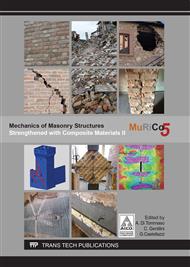[1]
D. Benedetti, P. Carydis, P. Pezzoli, Shaking table tests on 24 simple masonry buildings, Earthquake Engineering & Structural Dynamics, 27(1) (1998), 67-90.
DOI: 10.1002/(sici)1096-9845(199801)27:1<67::aid-eqe719>3.0.co;2-k
Google Scholar
[2]
G. Magenes, G.R. Kingsley, G.M. Calvi, Seismic testing of a full-scale, two-story masonry building: test procedure and measured experimental response, Consiglio nazionale delle ricerche, Gruppo nazionale per la difesa dai terremoti (1995).
DOI: 10.20333/25000136-2021-2-104
Google Scholar
[3]
M. Tomazevic, M. Lutman, L. Petkovic, Seismic behavior of masonry walls: experimental simulation, Journal of Structural Engineering, 122(9) (1996), 1040-1047.
DOI: 10.1061/(asce)0733-9445(1996)122:9(1040)
Google Scholar
[4]
M.C. Griffith, J. Vaculik, N.T.K. Lam, J. Wilson, E. Lumantarna, Cyclic testing of unreinforced masonry walls in two-way bending, Earthquake Engineering & Structural Dynamics, 36(6) (2007), 801-821.
DOI: 10.1002/eqe.654
Google Scholar
[5]
F. Graziotti, U. Tomassetti, A. Rossi, S. Kallioras, M. Mandirola, A. Penna, G. Magenes, Experimental campaign on cavity walls systems representative of the Groningen building stock, Report EUC318/2015U, Eucentre (2015), Pavia, Italy.
Google Scholar
[6]
P.H. Feenstra, J.G. Rots, A. Arnesen, J.G. Teigen, K.V. Hoiseth, A 3D constitutive model for concrete based on co-rotational concept, Computational modelling of concrete structures. Proc. EURO-C 1998, Eds. R. de Borst et al. (1998).
Google Scholar
[7]
S. Jafari, L. Panoutsopoulou, J.G. Rots, Tests for the characterisation of original Groningen masonry, Delft University of Technology. Final report 18 December (2015).
Google Scholar
[8]
EN 1052-1, Method of test masonry – Part 1: Determination of compressive strength, (1998).
Google Scholar
[9]
EN 1052-2, Method of test masonry – Part 2: Determination of flexural strength, (1999).
Google Scholar
[10]
EN 1052-5, Method of test masonry – Part 5: Determination of bond strength by bond wrench method, (2005).
DOI: 10.3403/30056187u
Google Scholar
[11]
EN 1052-3, Method of test masonry – Part 3: Determination of initial shear strength, (2002).
Google Scholar
[12]
S. Jafari, J.G. Rots, R. Esposito, F. Messali, Characterizing the material properties of Dutch unreinforced masonry, International Conference on Analytical Models and New Concepts in Concrete and Masonry Structures (2017).
DOI: 10.1016/j.proeng.2017.06.211
Google Scholar
[13]
F. Messali, G. Ravenshorst, R. Esposito, J. Rots, Large-scale testing program for the seismic characterization of Dutch masonry walls, 16th World Conference on Earthquake, WCEE 2017, 9-13 Jan. 2017, Santiago, Chile.
Google Scholar
[14]
R. Esposito, K.C. Terwel, G.J.P. Ravenshorst, H.R. Schipper, F. Messali, J. G Rots, Cyclic pushover test on an unreinforced masonry structure resembling a typical Dutch terraced house, 16th World Conference on Earthquake, WCEE 2017, 9-13 Jan. 2017, Santiago, Chile.
DOI: 10.1007/s10518-019-00572-w
Google Scholar
[15]
V. Mariani, F. Messali, M.A.N. Hendriks, J.G. Rots, Numerical modelling and seismic analysis of Dutch masonry structural components and buildings, 16th World Conference on Earthquake, WCEE 2017, 9-13 Jan. 2017, Santiago, Chile.
Google Scholar
[16]
J.G. Rots, F. Messali, R. Esposito, S. Jafari, V. Mariani, Computational modelling of masonry with a view to Groningen induced seismicity, 10th international conference on Structural Analysis of Historical Constructions, SAHC 2016, 13-15 Sept. 2016, Leuven, Belgium.
DOI: 10.1201/9781315616995-29
Google Scholar
[17]
G.M.A. Schreppers, A. Garofano, F. Messali, J.G. Rots, DIANA Validation report for Masonry modelling, DIANA FEA B. V (2016).
Google Scholar


